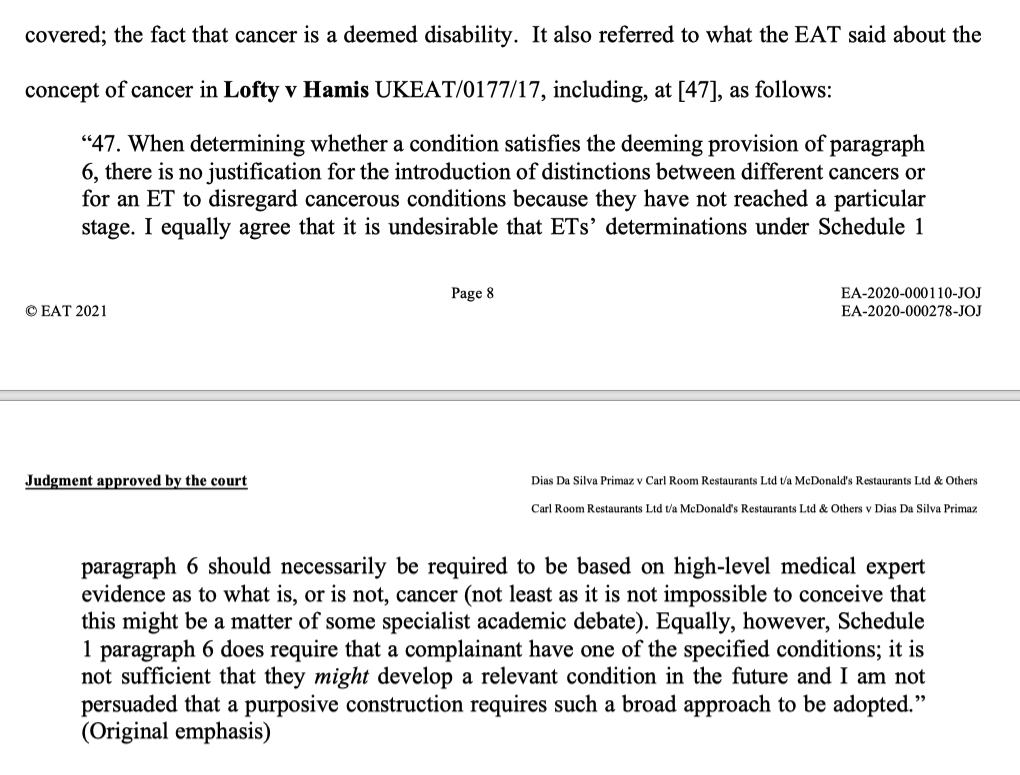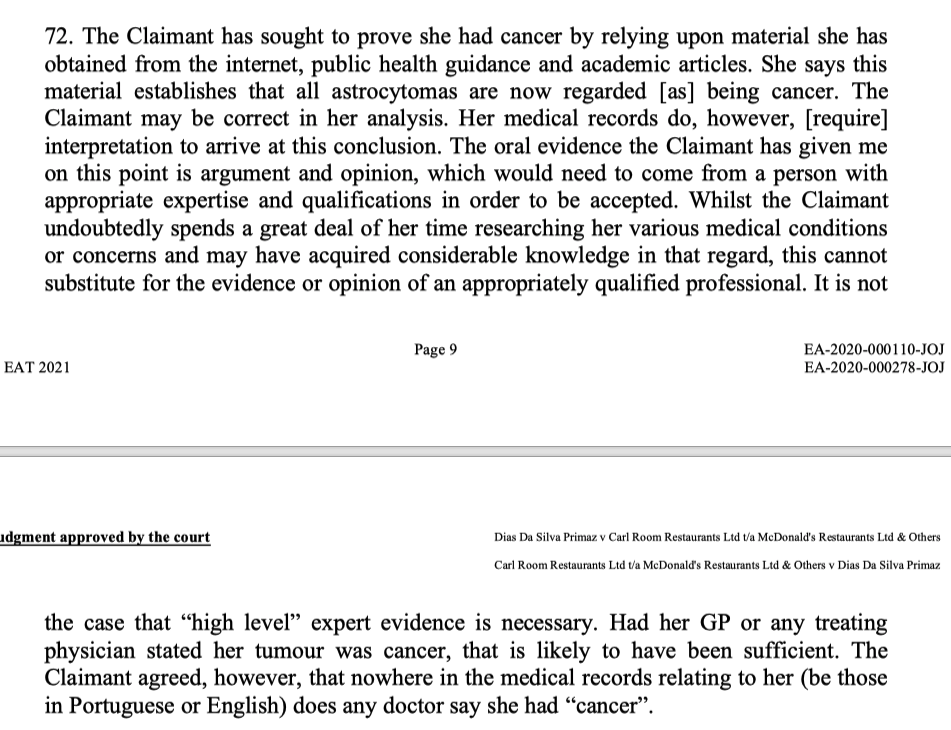1/ Dias Da Silva Primaz v McDonalds: A really useful disability case, with guidance on cancer as a disability - including post-remission - & whether/when avoidant behaviours may amount to a substantial adverse effect ('SAE')
bailii.org/uk/cases/UKEAT…
#ukemplaw
bailii.org/uk/cases/UKEAT…
#ukemplaw
2/ D works for a McDonalds franchise. She brought before the ET complaint of multiple disability discrim incidents. A PH was conducted to determine whether she was disabled as a result of cancer, epilepsy &/or vitiligo.
3/ There's a somewhat unusual history to this one. D was diagnosed with epilepsy in 1996. During investigations into this, a brain tumour was discovered. An op was carried out to remove it in 2008. A Portuguese medical report report called it a low grade astrocytic tumour.
4/ D's physician didn't say her tumour was cancerous, but it's D's case (on the basis of articles & PHE guidance) that all astrocytic tumours are classified cancerous. Also, her Drs told her the epilepsy would cease on removing the tumour. But...
5/ As the epilepsy continued, D reasoned the tumour can't have been entirely removed, so D claims she continues to suffer with cancer. D also says it can't be proved that no cancerous cells remain in her body.
6/ In considering whether D was disabled under EqA s.6 & Sch1, the ET considered Lofty v Hamis, where the EAT made clear that ETs shouldn't distinguish between different grades of cancer nor should they require high-level medical evidence before finding a claimant has cancer. 

7/ The ET found itself unable to find that the brain tumour (classified on removal as benign & low grade) was cancer. The medical evidence didn't refer to it as cancerous at the time or ever. Reliance on general academic articles/public health guidance wasn't enough. 

8/ The ET noted in any event the limited utility to D of asserting that as a result of a cancerous tumour in 2008 in respect of disability claims 10 years later. There was no medical evidence to show the tumour had resulted in D's epilepsy & vitiligo even though that can happen.
9/ The ET found D was disabled by her epilepsy, which included recurrent seizures as well as overwhelming concerns about SUDEP (Sudden Unexpected Death in Epilepsy), leading to avoidant behaviour.
The ET found also that D has vitiligo & that avoidant behaviours here were an SAE

The ET found also that D has vitiligo & that avoidant behaviours here were an SAE


10/ The ET also considered the effects on D of her epilepsy & vitiligo cumulatively, noting the overlap between the effects of each, holding that this in itself amounted to a SAE which was long term & more than minor or trivial. 

11/ D appealed in respect of the judgment she wasn't disabled through cancer. She said the ET should've accepted the PHE guidance that her type of tumour is always now classed as cancerous, & thus the ET also erred in failing to consider whether D's cancer continued post-op.
12/ The EAT drew 2 propositions from Lofty v Hamis: (i) a risk something could develop into cancer isn't enough; (ii) all cancers are deemed a disability, regardless of stage. If cancer cells are present, that's enough regardless of whether s.6(1) EqA would be satisfied. 

13/ The EAT found D had sufficiently proved she had cancer back in 2008. PHE guidance said astrocytic tumours are the commonest types of brain cancer - the natural meaning is that all astrocytic tumours are cancers. There was undisputed medical evidence this was what D had. 

14/ However, there was no basis on which to find D still had cancerous cells present in 2018. It's immaterial whether some physicians might describe a patient as being in remission when they once had cancer & no longer do. 

15/ Importantly, with little fanfare, that would seem to resolve a confusion previously not (I think) dealt with by the EAT as to whether it was the case that once diagnosed with cancer a person was always disabled thereafter. The answer appears to be no.
16/ The R appealed against the ET's findings of disability due to epilepsy & vitiligo. Principally the challenge was to the finding that D's fears & avoidant behaviours amounted to an SAE on D's ability to carry out normal day to day activities.
17/ Fleshed out, the R relied on a lack of evidence D would suffer adverse consequence by doing the activities she avoided, or that those fears (not objectively well-founded) themselves established the SAE.
18/ Alongside some perversity grounds, R also argued post-seizure symptoms, attending Drs & not going on sunny holidays weren't substantial adverse effects on D's normal day to day activities.
19/ The EAT emphasised that the SAE must be found to have been "caused by" the epilepsy &/or vitiligo. It wasn't suggested epilepsy itself caused aversion or avoidance behaviours in the way, eg, a mental phobia or OCD might. The causation test is an objective one. 

20/ It didn't suffice that the avoidant behaviours resulted from D acting on her belief that to participate in them could exacerbate/trigger her impairments. That was a simple 'but for' approach to causation, which didn't go far enough. 

21/ It wasn't sufficient to say but for having these conditions D wouldn't have engaged in the avoidant behaviours. It was necessary to show that 1 of the impairments had a requisite material causal effect on D's ability to carry out the activities in question as per s.6 EqA. 

22/ D's behaviours were contrary to clinical advice & it wasn't her case that her actions were anything other than wholly voluntary (through phobia, obsession or the like). She just considered her avoidance a wise & informed choice. The chain of causation wasn't made out. 



23/ Additionally, the EAT wasn't convinced by some of those things the ET found a SAE on normal day to day activities - the mere abstention from coffee, alcohol or cosmetics for example, or occasional visits to a Dr, or having to take a little extra care when exposed to the sun. 





24/ Finally, whilst not persuaded the avoidant behaviours was an SAE, the EAT remitted back to the ET the question whether frequent nocturnal seizures with their impact on D's sleep was, on its own, a SAE. The EAT's steer was heavily in favour of finding it was. 

• • •
Missing some Tweet in this thread? You can try to
force a refresh








